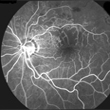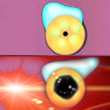Monday, 3 June 2013
Seeing What’s in Your Eye

The structure of your eye is a lot like that of a traditional film camera. The lens of your eye is like the camera’s lens. Your iris is like the diaphragm, and your retina, at the very back of the eye, acts like the light-sensitive film.
However, there is a hole in your retina that lets the axons of its ganglion cells (a kind of neuron) exit the eye while letting blood vessels enter to irrigate all of the retina’s neurons. This hole creates a true “blind spot” in your field of vision. You don’t notice this blind spot in your daily life. (more…)
The Senses | Comments Closed
Monday, 22 October 2012
Optogenetics: Neurons Controlled by Light

Among the many new techniques developed in the neurosciences in recent years, few have caused as much of a stir as optogenetics. This strange marriage between the sciences of optics and genetics allows the activity of entire populations of neurons in the brains of living animals to be controlled with a simple ray of light. Just a decade or two ago, such a technique, which is relatively non-invasive and accurate to within one millisecond, would have been unimaginable! (more…)
Emotions and the Brain, The Senses | Comments Closed







